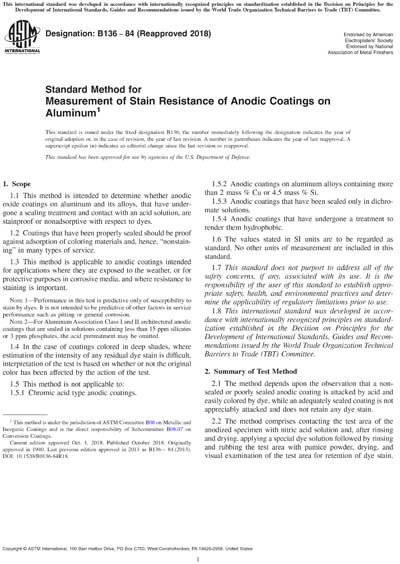Historical
ASTM B136-84(2018)
Standard Method for Measurement of Stain Resistance of Anodic Coatings on Aluminum
1.1 This method is intended to determine whether anodic oxide coatings on aluminum and its alloys, that have undergone a sealing treatment and contact with an acid solution, are stainproof or nonadsorptive with respect to dyes.
1.2 Coatings that have been properly sealed should be proof against adsorption of coloring materials and, hence, “nonstaining” in many types of service.
1.3 This method is applicable to anodic coatings intended for applications where they are exposed to the weather, or for protective purposes in corrosive media, and where resistance to staining is important.
Note 1: Performance in this test is predictive only of susceptibility to stain by dyes. It is not intended to be predictive of other factors in service performance such as pitting or general corrosion.
Note 2: For Aluminum Association Class I and II architectural anodic coatings that are sealed in solutions containing less than 15 ppm silicates or 3 ppm phosphates, the acid pretreatment may be omitted.
1.4 In the case of coatings colored in deep shades, where estimation of the intensity of any residual dye stain is difficult, interpretation of the test is based on whether or not the original color has been affected by the action of the test.
1.5 This method is not applicable to:
1.5.1 Chromic acid type anodic coatings.
1.5.2 Anodic coatings on aluminum alloys containing more than 2 mass % Cu or 4.5 mass % Si.
1.5.3 Anodic coatings that have been sealed only in dichromate solutions.
1.5.4 Anodic coatings that have undergone a treatment to render them hydrophobic.
1.6 The values stated in SI units are to be regarded as standard. No other units of measurement are included in this standard.
1.7 This standard does not purport to address all of the safety concerns, if any, associated with its use. It is the responsibility of the user of this standard to establish appropriate safety, health, and environmental practices and determine the applicability of regulatory limitations prior to use.
1.8 This international standard was developed in accordance with internationally recognized principles on standardization established in the Decision on Principles for the Development of International Standards, Guides and Recommendations issued by the World Trade Organization Technical Barriers to Trade (TBT) Committee.
ASTM International [astm]

